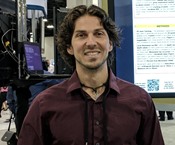Program Information
Markerless Motion Management Utilizing Kinect V2 Sensor
E Silverstein*, M Snyder , Wayne State University, Detroit, MI
Presentations
WE-RAM2-GePD-J(B)-1 (Wednesday, August 2, 2017) 10:00 AM - 10:30 AM Room: Joint Imaging-Therapy ePoster Lounge - B
Purpose: Investigation of markerless motion management utilizing body and skeletal tracking with Kinect v2 Sensor.
Methods: The Kinect software contains automatic body recognition features for up to 6 bodies in front of the camera. Once identified, the system creates a skeletal structure mapped to the body with 25 specific body joints (head, elbow, knee, etc) making up the skeletal frame. Although approximate in their actual anatomical location, each is locked to relative positions on the body based on contours and depth data obtained by the depth sensor. Using code written in C#, these joints are tracked, in 3D space, and compared to an initial state of the patient allowing for an indication of gross motion.Additionally, code was written to compare depth data recorded by the Kinect across a specific ROI drawn by the user. Here, the depth values of all pixels associated with the body in the ROI are compared to the initial state. The number of live pixels with a depth difference greater than a specified threshold compared to the initial state are counted and the percentage of those outside the threshold indicate how much motion has occurred.
Results: Tracking of joint positions indicated a linear correlation between actual and recorded distance in all three special directions but with a low sensitivity of movement below 5mm. Calculation of pixel depth differences within an ROI indicate a strong sensitivity of movement in the Z and X direction for movements greater than 2mm but with a lower sensitivity in the Y direction.
Conclusion: Both solutions created allow for tracking of gross motion with differing levels of sensitivity. While the tracking of skeletal joints provides an automatic process for motion management with decreased sensitivity for small movement values, a combination of both processes can prove useful for smaller motions.
Contact Email:
